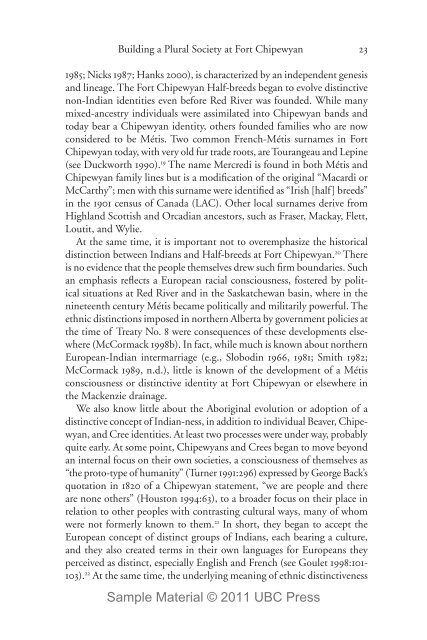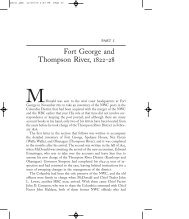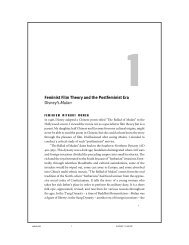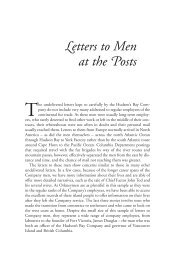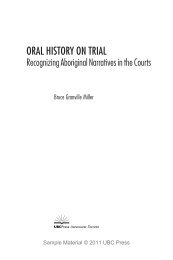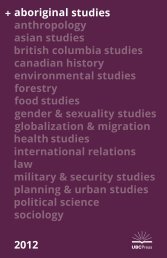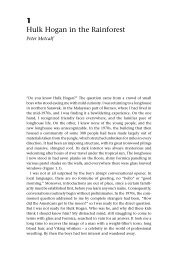Fort Chipewyan and the Shaping of Canadian History ... - UBC Press
Fort Chipewyan and the Shaping of Canadian History ... - UBC Press
Fort Chipewyan and the Shaping of Canadian History ... - UBC Press
You also want an ePaper? Increase the reach of your titles
YUMPU automatically turns print PDFs into web optimized ePapers that Google loves.
Building a Plural Society at <strong>Fort</strong> <strong>Chipewyan</strong><br />
1985; Nicks 1987; Hanks 2000), is characterized by an independent genesis<br />
<strong>and</strong> lineage. The <strong>Fort</strong> <strong>Chipewyan</strong> Half-breeds began to evolve distinctive<br />
non-Indian identities even before Red River was founded. While many<br />
mixed-ancestry individuals were assimilated into <strong>Chipewyan</strong> b<strong>and</strong>s <strong>and</strong><br />
today bear a <strong>Chipewyan</strong> identity, o<strong>the</strong>rs founded families who are now<br />
considered to be Métis. Two common French-Métis surnames in <strong>Fort</strong><br />
<strong>Chipewyan</strong> today, with very old fur trade roots, are Tourangeau <strong>and</strong> Lepine<br />
(see Duckworth 1990). 19 The name Mercredi is found in both Métis <strong>and</strong><br />
<strong>Chipewyan</strong> family lines but is a modification <strong>of</strong> <strong>the</strong> original “Macardi or<br />
McCarthy”; men with this surname were identified as “Irish [half] breeds”<br />
in <strong>the</strong> 1901 census <strong>of</strong> Canada (LAC). O<strong>the</strong>r local surnames derive from<br />
Highl<strong>and</strong> Scottish <strong>and</strong> Orcadian ancestors, such as Fraser, Mackay, Flett,<br />
Loutit, <strong>and</strong> Wylie.<br />
At <strong>the</strong> same time, it is important not to overemphasize <strong>the</strong> historical<br />
distinction between Indians <strong>and</strong> Half-breeds at <strong>Fort</strong> <strong>Chipewyan</strong>. 20 There<br />
is no evidence that <strong>the</strong> people <strong>the</strong>mselves drew such firm boundaries. Such<br />
an emphasis reflects a European racial consciousness, fostered by political<br />
situations at Red River <strong>and</strong> in <strong>the</strong> Saskatchewan basin, where in <strong>the</strong><br />
nineteenth century Métis became politically <strong>and</strong> militarily powerful. The<br />
ethnic distinctions imposed in nor<strong>the</strong>rn Alberta by government policies at<br />
<strong>the</strong> time <strong>of</strong> Treaty No. 8 were consequences <strong>of</strong> <strong>the</strong>se developments elsewhere<br />
(McCormack 1998b). In fact, while much is known about nor<strong>the</strong>rn<br />
European-Indian intermarriage (e.g., Slobodin 1966, 1981; Smith 1982;<br />
McCormack 1989, n.d.), little is known <strong>of</strong> <strong>the</strong> development <strong>of</strong> a Métis<br />
consciousness or distinctive identity at <strong>Fort</strong> <strong>Chipewyan</strong> or elsewhere in<br />
<strong>the</strong> Mackenzie drainage.<br />
We also know little about <strong>the</strong> Aboriginal evolution or adoption <strong>of</strong> a<br />
distinctive concept <strong>of</strong> Indian-ness, in addition to individual Beaver, <strong>Chipewyan</strong>,<br />
<strong>and</strong> Cree identities. At least two processes were under way, probably<br />
quite early. At some point, <strong>Chipewyan</strong>s <strong>and</strong> Crees began to move beyond<br />
an internal focus on <strong>the</strong>ir own societies, a consciousness <strong>of</strong> <strong>the</strong>mselves as<br />
“<strong>the</strong> proto-type <strong>of</strong> humanity” (Turner 1991:296) expressed by George Back’s<br />
quotation in 1820 <strong>of</strong> a <strong>Chipewyan</strong> statement, “we are people <strong>and</strong> <strong>the</strong>re<br />
are none o<strong>the</strong>rs” (Houston 1994:63), to a broader focus on <strong>the</strong>ir place in<br />
relation to o<strong>the</strong>r peoples with contrasting cultural ways, many <strong>of</strong> whom<br />
were not formerly known to <strong>the</strong>m. 21 In short, <strong>the</strong>y began to accept <strong>the</strong><br />
European concept <strong>of</strong> distinct groups <strong>of</strong> Indians, each bearing a culture,<br />
<strong>and</strong> <strong>the</strong>y also created terms in <strong>the</strong>ir own languages for Europeans <strong>the</strong>y<br />
perceived as distinct, especially English <strong>and</strong> French (see Goulet 1998:101-<br />
103). 22 At <strong>the</strong> same time, <strong>the</strong> underlying meaning <strong>of</strong> ethnic distinctiveness<br />
Sample Material © 2011 <strong>UBC</strong> <strong>Press</strong><br />
23


